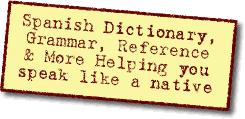Ask a Question(Create a thread) |
|
|||||||
Interesting word ClaveVocab questions, definitions, usage, etc |
 |
|
|
Thread Tools |
|
Get rid of these ads by registering for a free Tomísimo account.
|
|
#2
|
||||
|
||||
|
La clave is the Spanish word for 'clef' (and it also happens to be the word for the musical term 'key' (there is another word for the key that opens a lock--la llave)).
In English, 'clef' and 'key' do not mean the same things, in musical terms. The clef is the sign placed on a staff, or stave that designates a certain pitch, or note. For example, the treble clef, also called the G-clef (Spanish: clave de sol), designates the line assigned to the pitch 'G4' (the clef sign makes a cross-hair on that line of the staff). Here is a picture of the treble clef. The alto clef is called the C-clef because it marks the line assigned to 'C4'. Here it is on a stave. The bass clef is known as the F-clef (Spanish: clave de fa). It has a dot above and a dot below the line assigned to 'F3'. Here it is on a staff. The key in which a piece of music is written is designated after the clef sign, using sharp signs or flat signs (or the absence thereof, in the case of a piece written in C Major or A Minor) placed on lines or spaces of the staff. The key, or 'key signature', tells the performer what pitches to play on the marked lines or spaces. Here is 'Ode to Joy' in the key of C Major. There are no sharps or flats in this key (no sharp or flat signs between the clef sign and the time signature). Here is the same song in the key of F Major. Note the flat sign appearing between the clef sign and the time signature, on the line assigned to B4. That means the performer should play every note appearing on that line as B flat, a half-tone below B4. In music, the English word 'clave' is a musical instrument, usually used in pairs. Here you can find a picture of claves (Spanish: las claves). |
 |
«
Previous Thread
|
Next Thread
»
| Link to this thread | |
|
|
|||||||
 Similar Threads
Similar Threads
|
||||
| Thread | Thread Starter | Forum | Replies | Last Post |
| Dialects of Spanish are so interesting! | Villa | General Chat | 48 | October 08, 2013 08:41 PM |
| Word, lexeme, word-form, morpheme, morph, allomporh | ROBINDESBOIS | Grammar | 2 | May 26, 2010 10:35 AM |
| This is like an interesting puzzle.... | hola | Grammar | 1 | May 19, 2009 07:33 PM |
| A very interesting site for language learners | tacuba | Teaching and Learning Techniques | 13 | April 26, 2009 10:12 AM |
| Interesting... | chileno | Teaching and Learning Techniques | 12 | April 11, 2009 10:49 PM |
All times are GMT -6. The time now is 03:16 AM.






